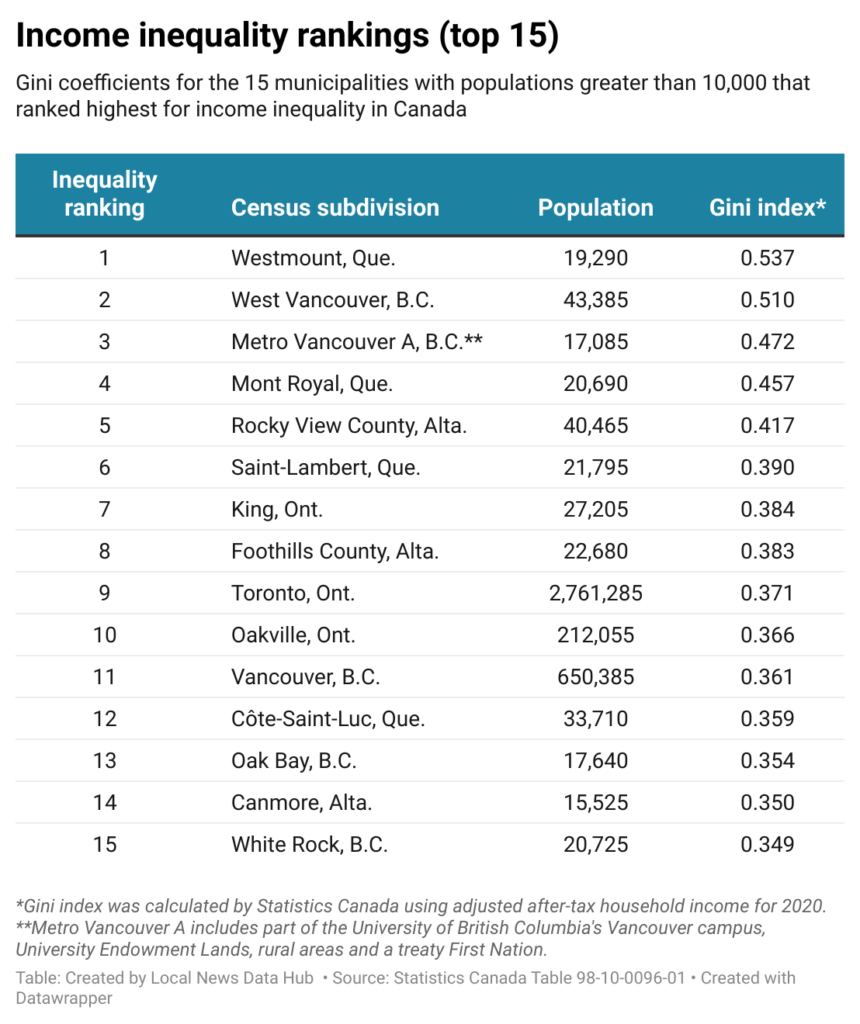
Toronto, King Township and Oakville all rank in Canada’s top 10 for income inequality, analysis finds
Aurora and Richmond Hill are also among the worst in the country

By Carly Penrose
Local News Data Hub
Sept. 21, 2023
Income inequality, known for its corrosive effects on health, happiness and community ties, is worse in Toronto and four other GTA municipalities than in most places in Canada, according to a new analysis of Statistics Canada data.
Toronto ranked ninth for household income inequality on a national ranking assembled by the Local News Data Hub at Toronto Metropolitan University. King Township ranked seventh while Oakville was 10th.
Two other GTA municipalities, Aurora (19th) and Richmond Hill (tied for 22nd), also made the list of the top 25 places in Canada with the widest household income gaps between high- and low-income residents.
For Gloria Priest, who has lived on both sides of Oakville’s income divide, the consequences of being poor in one of Canada’s most unequal places are very real.
Priest was well-to-do until she got divorced, she said. Then her household income fell below the poverty line and she moved to a different neighbourhood.
Now on the rare occasion when she sees people from her former life, some are kind, some don’t recognize her, and others “make that sniffly look, like I’m unpleasant,” she said.
In places with more significant inequality, high- and low-income residents tend to “become socially isolated among people like themselves,” said Ivan Townshend, a social geographer at the University of Lethbridge.
People of different means have fewer opportunities to cross paths when neighbourhoods separate those who “have” from those who “have not,” Townshend said. The isolation can make it easier for rich and poor to form ideas about each other based on stereotypes, not facts, and then blame the other group for social ills, he added.
Income inequality has been linked to a reduced sense of community belonging, greater distrust among residents, more financial worries and increased anxiety about social status — outcomes all associated with lower levels of happiness and poorer mental and physical health. Research has also associated big income gaps with greater political polarization and increases in theft and vandalism fuelled by desperation and a sense of unfairness.
To compare income inequality across Canada, the Local News Data Hub ranked the country’s 418 municipalities with more than 10,000 people using Statistics Canada’s 2020 Gini index for adjusted after-tax household income.
The Gini index is an internationally recognized tool statisticians use to measure how income is distributed across a society. Income, in this case, takes into account wages, pension income, investment earnings such as dividends and interest, and government transfers like social assistance. The number 1 ranked municipality had the highest level of inequality.
The national ranking, which was reviewed by Statistics Canada senior research analyst Xuelin Zhang, points to significant variations among communities. For instance:
- There were major differences in income inequality among Canadian cities with more than 200,000 people. Toronto was ninth on the overall Gini ranking, Vancouver was 11th, and Montreal was 29th. Mississauga, Ont., was further down at 64th while nearby Brampton, Ont., was close to the bottom at 374th.
- The highest-earning 10 per cent of Brampton households make three times more than the lowest earners. In more unequal places like Toronto and Oakville, the top group makes around five times more.
- The widest gap between high- and low-income residents in Canada was in Westmount, Que., home to about 20,000 people. In Westmount’s richest neighbourhood the median household income is $360,000, according to data from the non-profit Centraide Montreal. The municipality, however, also includes people who live in extremely low-income neighbourhoods on its periphery. The highest-earning 10 per cent of households in Westmount made nearly 11 times more than the lowest earners in 2020.

Income inequality is inextricably linked to unequal opportunity, which can start at an early age, said Ruth Crammond from the United Way Greater Toronto.
Crammond, the agency’s vice president, community investment and development, pointed to the uneven impact of the pandemic lockdowns on education for high- and low-income households.
In some homes, she said, “there was one computer for a family with three kids and people had to try to do homework.” Meanwhile, affluent families could afford more technology and even tutors for children when schools were shut down.
“That falling behind sort of layers on as people move through their lives with unequal access to services, to resources,” Crammond said.
In cities like Toronto, low-income people are displaced to the more affordable periphery of the city. This creates an “out of sight, out of mind” mentality, said Nicholas Lynch, a geography professor at Memorial University in Newfoundland who has studied neighbourhood changes in Canada as a result of income inequality.
“You push all the middle- and lower-income people to the margins of the city … then kind of forget about them. You put more of your investment, time and money into the downtown core for the people that have the money for all of the amenities.”
Crammond said it is particularly difficult for social service agencies to help people in need in more rural areas like King Township because they are so spread out. The township, located north of Toronto, has just over 27,000 residents and a relatively high median after-tax household income of $117,000. But there are still about 1,600 people living below the low-income measure, Crammond said.
“Poverty is really challenging for those folks. They may be more isolated because of the transportation challenges and the fact that services are harder to get,” Crammond said.
Statistics Canada data show income inequality declined nationally between 2015 and 2020, largely due to the Canada Child Benefit introduced in 2016 and pandemic-related government transfers like the Canada Emergency Response Benefit (CERB). But David Macdonald, an economist at the Canadian Centre for Policy Alternatives in Ottawa, said inequality and poverty are expected to rise now that CERB payments have ended.
Macdonald also pointed out that the Gini measure tends to underestimate inequality because it is calculated based only on income data and doesn’t include inherited wealth, capital gains or non-financial assets like real estate. “If you include capital gains in the definition of income,” he added, “then you actually see income inequality grow.”
A recent Statistics Canada report illustrated Macdonald’s point. The wealthiest 20 per cent of households controlled two-thirds of the country’s net worth as of early 2023, the report says, while the bottom 40 per cent accounted for just 2.7 per cent. The report also noted that the wealth gap between rich and poor in Canada widened at the fastest pace on record in the first quarter of this year. Compared to the wealthiest households, lower-income Canadians accumulated more debt, saw their savings shrink and received less investment income.
Social justice advocates say there are many ways to reduce income inequality. Bridget Clarke, the advocacy co-ordinator at the St. John’s Status of Women Council in Newfoundland, said stronger pay equity legislation would help.
Labour organizations argue for increases in social assistance, paid sick days, a higher minimum wage and updated labour laws that reduce the number of precarious jobs, address discrimination in the workplace and make it easier for workers to unionize.
Last year, Halifax Regional Council and the Union of BC Municipalities both passed resolutions calling for a federally funded guaranteed basic income.
This story was produced by the Local News Data Hub, a project of the Local News Research Project at Toronto Metropolitan University’s School of Journalism. The Canadian Press is the Data Hub’s operational partner. Detailed information on the data and methodology can be found here.